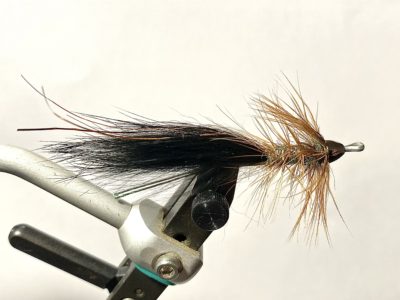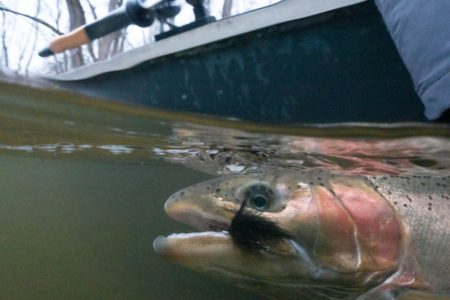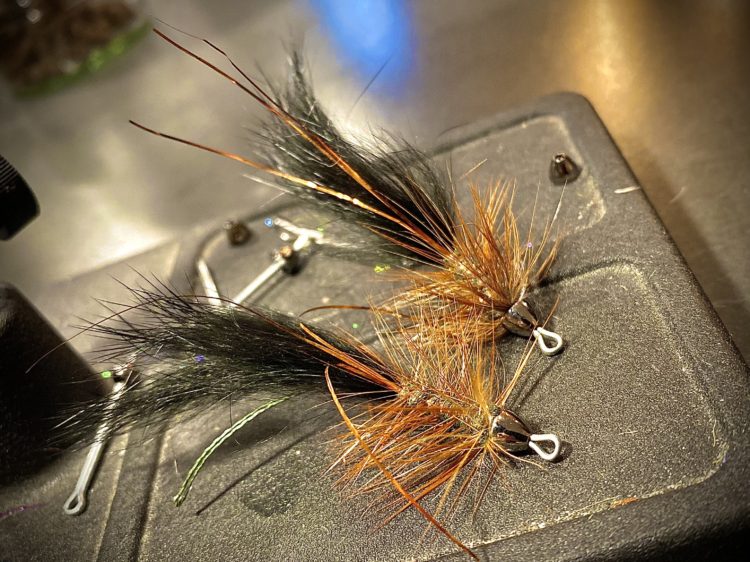Peacock Bugger
This is a very simple fly but it can be very effective as a swung fly tied on a shank or as a nymph tied on a hook.

When I first started fishing the Muskegon for steelhead, my fly selection was pretty limited. Back then if you looked in my box you would see a variety of eggs, ice minnows, small sculpins, and peacock buggers. That’s about it! Depending on the time of year, one or the other of those options would usually get it done. One fly outshined the rest of them. No matter what time of the year it was, I always had confidence when there was a peacock bugger on the end of my line. Not much has changed since then. Whether you are swinging flies, or nymphing this simple twist on the old classic is a great option to have in your box.
Steelhead can often leave you scratching your head. Throughout the season there are periods when they seem to bite anything that comes into view, and periods when its hard to buy a bite. Over the years, in the the tough times I have riffled through my boxes in search of something to peak their interest. Often if I pick a peacock bugger it gets the job done.
I think the reason that woolly buggers work so well is that the can represent a wide variety of different things. Add a color combo that is well proven in the Muskegon, and you have a great fly. A bugger swung or drifted around the gravel in the fall can look like a leech. They can imitate baitfish and helgramites. On days in the spring when the stonefly nymphs are really swimming, it’s a great bet to have a small peacock bugger on your line.
When you think of good swinging flies for steelhead you might typically think of big, bright, and flashy patterns. Well those flies do catch plenty of fish, there are periods of the season when i have been leaning towards smaller and sparser flies. When the fish are seeing a lot of pressure and traffic on the water. Or when the water is very clear, I typically will lean towards flies like these.
This year we had a long period of ultra clear water. I had been guiding swung fly trips every day, and had been really working hard to get fish to bite. I had one day of nymph fishing in between all of the swinging trips. I hadn’t nymph fished in close to two months, so I was a little out of the loop on which flies would produce. The first thing in the morning I put some flies on I thought would be productive. We fished till lunch with only a few trout to hand. After lunch I decided to tie on the old standard peacock bugger. Throughout the afternoon we hooked fish in most of the spots we tried. They all were on the peacock bugger. I knew after that one day of nymphing I was back to swinging flies for the next few weeks. So that night I tied a handful of copper peacock buggers on shanks for swinging. The next day we hooked a fish on one of the first few casts on a shank style peacock bugger.
This fly worked well for me for the rest of the late fall/early winter. Hopefully having a few in your box will help you find a fish on the tough days.
Peacock Bugger Materials List:
Hook: 1″ Shank or 2X Strong Wet Fly Hook Size 4-8
Loop: 40-50lb Braid tied about the same length as the shank.
Optional Weight: Tungsten or Brass Cone depending on water levels. This fly is just as effective when it is tied unweighted. I typically use unweighted flies when I tie them on a hook and use them for nymphing.
Tail: 3/4″ Piece of Black Rabbit Strip, or Black Marabou. When I need to tie a bunch of these I like to pre-cut a bunch of tails out of rabbit strips.
Flash: A few strands of copper Flashabou is most effective for me but don’t be afraid to experiment with other flashes.
Hackle: Brown Schlappen or Strung Saddle Hackle palmered through the body.
Body: Peacock Ice Dubbing

Kevin shot this great photo of a fish that was recently caught on a Peacock Bugger


0 Comments